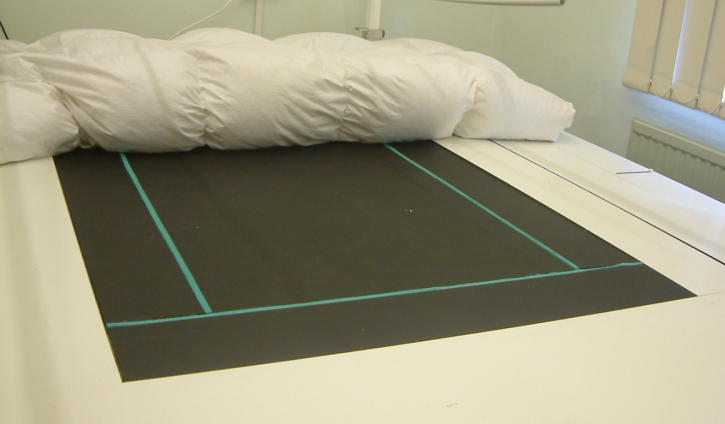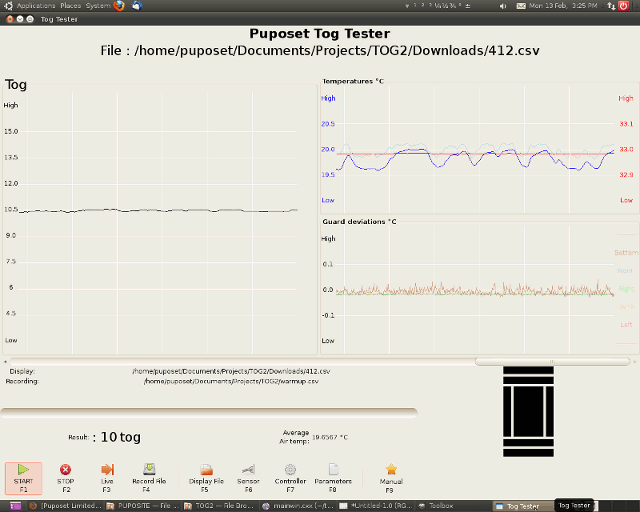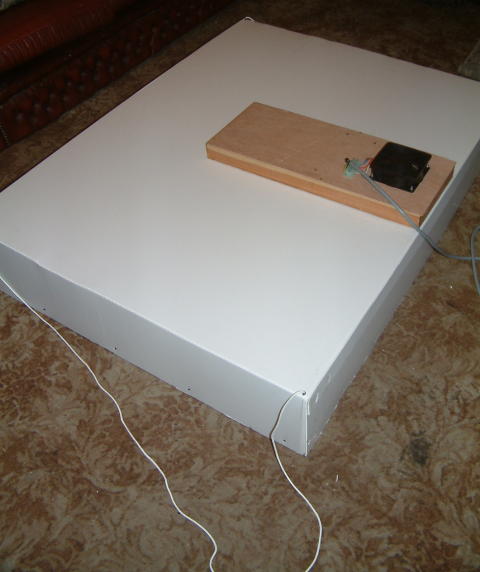


Tog Tester
An instrument to measure the thermal resistance of bed-quilts in the range from 4 to 18 tog. in accordance with BS 5335 using the guarded hotplate principle (
Principles of tog testing).
The equipment consists of a long life anodized aluminium hotplate assembly, a computer control unit and a set of air temperature sensors. The test procedure is is fully automatic, no additional calculation required.
The instrument is designed with ease of long term maintenance in mind. The control system is based on a standard PC using only open-source software, so maintenance does not depend on the continued existence of suppliers


Simple push-button test operation.
Place a conditioned quilt on the hotplate. Press the start button. When test is complete, a green light comes on. The tog value can be read from a local VDU and a certificate printed from a network PC.
To construct a tog measurement laboratory requires
- This instrument
- A closed air conditioned room maintained near 20°C and 65%RH
- A table to support the hotplate and on which the quilt can lie flat
- A moveable frame (or optional regulating hood) to support the air temperature sensor array about 100mm above the quilt.
- A storage area at nominally the same temperature and humidity for pre-conditioning the quilts
- 230V AC mains supply fused at 5A
- Network or other communications connection.
- A (non-dedicated) PC or terminal for recording results.
- Annual calibration to national reference sample
The control system is based on a Linux PC, intended primarily to act as a network data server, although local output is available. The operating system, data acquisition system and test procedure are entirely open-source software, so can be maintained by third parties.
Supervisory software includes status indicators for all heaters, and real-time graphical display of tog value and temperatures of air, hotplate and guards.
Client software for printing certificates on a PC running Microsoft Windows™ is included.

Air conditioning
To meet British Standards the air conditioning must provide air temperature stable to ±0.1°C; in the case of BS5335, over hours. This can be achieved if a standard air conditioner is run in "proportional" mode and a large plenum is provided to smooth the airflow, for example distributing the air through the room ceiling cavity, or if the air conditioner includes a regulated post-cooling heater to provide precise temperature control.
Air conditioning requirements
A controlling hood for the BS5335 instrument is available as an alternative method of smoothing the temperature fluctuations from a standard air conditioner. The hood draws in air from the room and uses Peltier effect elements to cool or heat it to a precisely controlled temperature and distributes it over the bed.
- Replaces the air temperature sensor frame of the standard instrument.
- Requires a hoist or other moveable support arrangement.
- Requires that the room temperature remain within the textile conditioning range (18-22°C and 65±5% RH).
- Not a subsitute for conventional air conditioning and does not control humidity.
- Significantly increases the heat output of the rig, and therefore the load on the room air conditioner.
- Offers some protection against draughts in the room.
Prices
BS5335 instrument complete with delivery and installation in the mainland UK is £6000
Optional Peltier-effect hood £1000
Optional mounitng frame with conditioning rack for 3 quilts £1200
Does not include air conditioning, reference materials etc.
All prices exclude VAT, which for EU customers is charged at the UK rate.
For overseas orders, please call.
Technical details
This is a precision instrument requiring minimal calibration and capable of 1% accuracy given suitable environmental controls.
Hotplate and guard plate temperature 33°C ±0.1°C
Temperature variations across surface and between plates less than 0.02°C
Over-temperature protection on all heaters
Heat output during test 5-18W. Extraneous heatflows less than 20mW.
Guard temperature control by thermopile sensor with chopper stabilised thermally controlled amplifiers giving uncalibrated accuracy better than 0.005°
Absolute temperature sensing by platinum resistance sensor with chopper stabilised amplifier giving stability of around 0.1° per year.
Dimensions
- Main hotplate: 1.0m x 0.68m
- Working area, with guard plates: 1.32m x 1.0m
- Table size 2.2m x 1.7m (or as requested)
- Bed height 13.5cm
Warm-up time approx 5 hours.
Test time: minumum 5 hours, but depends on air temperature stability and quilt construction. Typically runs one test per 8-hour shift.
Hotplate powered from a stabilised DC supply with voltage and current measured independently and continuously.
Computer interface includes auto-calibration facility which guarantees voltage measurements to 0.1%
Software implements procedure BS5335-1:1991 Appendix D section 4. Other procedures available on request.
All system temperatures over entire measurement cycle recorded for validation.
Local VDU output can report results and test progress.
The instrument measures the heatflow and average plate and air temperatures
over the hotplate area using five-point probes.
A temperature output to a remote-sensing air conditioning unit can be provided
Software can be upgraded over the internet.
Compliant with CE regulations for electrical safety and EMC.
Hood Specifications
Intake temperature range 18-22°C
Air exit velocity 5cm/s
Cooler power 260W
Total power input 700W
Weight approx 20kg




